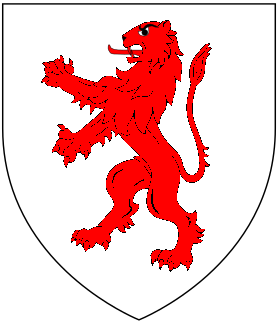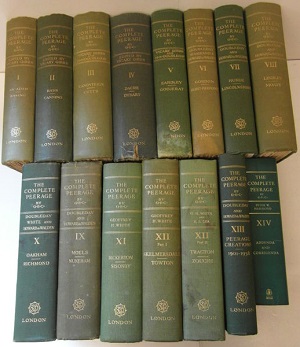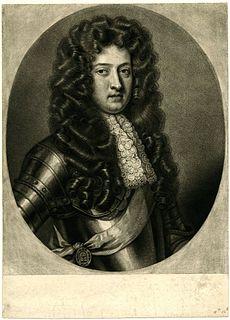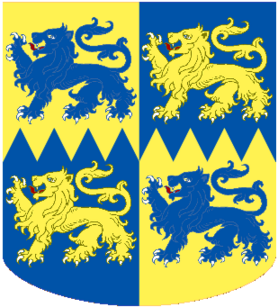Related Research Articles

Baron Aberdare, of Duffryn in the County of Glamorgan, is a title in the Peerage of the United Kingdom. It was created on 23 August 1873 for the Liberal politician Henry Bruce. He served as Home Secretary from 1868 to 1873. His grandson, the third Baron, was a soldier, cricketer and tennis player and a member of the International Olympic Committee. His son, the fourth Baron, held office in the Conservative administration of Edward Heath and was later a Deputy Speaker of the House of Lords. Lord Aberdare was one of the ninety-two elected hereditary peers that were allowed to remain in the House of Lords after the passing of the House of Lords Act 1999. As of 2017 the title is held by his son, the fifth Baron, who succeeded in 2005 and was elected to the House of Lords in 2009.
The Dukedom of Albemarle has been created twice in the Peerage of England, each time ending in extinction. Additionally, the title was created a third time by James II in exile and a fourth time by his son the Old Pretender, in the Jacobite Peerage. The name Albemarle is derived from the Latinised form of the French county of Aumale in Normandy, other forms being Aubemarle and Aumerle. It arose in connection with the ancient Norman Counts of Aumale of Aumale in Normandy. See also Earl of Albemarle.
Baron Abercromby, of Aboukir and of Tullibody in the County of Clackmannan, was a title in the peerage of the United Kingdom. It was created on 28 May 1801 for Mary, Lady Abercromby, in honour of her husband, the noted military commander Lieutenant-General Sir Ralph Abercromby, who died from wounds received in the Battle of Aboukir in 1801. The latter was the grandson of Alexander Abercromby, member of the Scottish Parliament for Clackmannanshire from 1703 to 1707, younger son of Sir Alexander Abercromby, 1st Baronet, of Birkenbog. Lady Abercromby was succeeded by her eldest son, George, the second baron. He represented Edinburgh and Clackmannan in the House of Commons. On his death the title passed to his son George, the third baron. He sat as Member of Parliament for Clackmannanshire, Stirling and Clackmannan and Kinross. He was succeeded by his eldest son, the fourth baron. He was deputy lieutenant of Stirlingshire in 1860. He was childless and was succeeded by his younger brother John, the fifth baron. He was president of the Society of Antiquaries of Scotland. On his death in 1924 without male issue the barony became extinct.
Viscount Aboyne was a title in the Peerage of Scotland. It was created on 20 April 1632 for George Gordon, Earl of Enzie, eldest son of George Gordon, 1st Marquess of Huntly, with remainder that the title should pass to his second son the Hon. James Gordon on his death or on the death of his father, whichever came first. On Lord Huntly's succession to the marquessate in 1636 the viscountcy passed according to the special remainder to his second son, the second Viscount. He never married and on his death in 1649 the title became extinct.
Earl of Aboyne is a title in the Peerage of Scotland, borne in the Gordon family.

Earl of Aldborough, of the Palatinate of Upper Ormond, was a title in the Peerage of Ireland held by the Stratford family. It was created on 9 February 1777, along with the courtesy title of Viscount Amiens, for John Stratford, 1st Viscount Aldborough, a descendant of the English Stratford family. He had already been created Baron Baltinglass, of Baltinglass, in the County of Wicklow, on 21 May 1763, and Viscount Aldborough, of the Palatinate of Upper Ormond, on 22 July 1776. These titles were also in the Peerage of Ireland. Three of his sons, the second, third and fourth Earls, all succeeded in the titles. They became extinct on the death of the latter's grandson, the sixth Earl, in 1875.
Baron Allerton, of Chapel Allerton in the West Riding of the County of Yorkshire, was a title in the Peerage of the United Kingdom. It was created on 17 July 1902 for the businessman and Conservative politician William Jackson. The title became extinct on the death of his grandson, the third Baron, on 1 July 1991.
Roger de Clare, 2nd Earl of Hertford, 5th Lord of Clare, 5th Lord of Tonbridge, 5th Lord of Cardigan (1116–1173) was a powerful Norman noble in 12th-century England. He succeeded to the Earldom of Hertford and Honor of Clare, Tonbridge and Cardigan when his brother Gilbert died without issue.
Gilbert Fitz Richard, was styled de Clare, de Tonbridge, and Lord of Clare. He was a powerful Anglo-Norman baron who was granted the Lordship of Cardigan, in Wales c. 1107–1111.

The Complete Peerage is a comprehensive and magisterial work on the titled aristocracy of the British Isles.

John Egerton, 3rd Earl of Bridgewater KB PC was a British nobleman from the Egerton family.

General Richard Airey, 1st Baron Airey,, known as Sir Richard Airey between 1855 and 1876, was a senior British Army officer of the 19th century.
Baron Boteler was a title that was created three times in the Peerage of England.
George Hamilton, 3rd Earl of Abercorn died unmarried in Padua on a voyage to Rome. He was succeeded by Claud Hamilton, heir of Claud Hamilton, 2nd Baron Hamilton of Strabane, second son of the 1st Earl of Abercorn.
Reginald William Bransby Nevill, 2nd Marquess of Abergavenny JP, styled Viscount Nevill between 1868 and 1876 and Earl of Lewes between 1876 and 1915, was a British peer.
Robert de Ferrers, 3rd Baron Ferrers of Chartley, was the son of John de Ferrers, 1st Baron Ferrers of Chartley and Hawise de Muscegros, a daughter of Robert de Muscegros.

John Stratford, 1st Earl of Aldborough was an Irish peer and politician and member of the Noble House of Stratford.

Maurice FitzMaurice FitzGerald, 2nd Earl of Desmond was the son of Maurice FitzGerald, 1st Earl of Desmond, and his first wife, Catherine de Burgh.

Thomas Cromwell, 3rd Earl of Ardglass, was an English nobleman, the only son of Wingfield Cromwell, 2nd Earl of Ardglass of Ilam, Staffordshire and Mary Russell. He held the subsidiary titles of 3rd Viscount Lecale and 6th Baron Cromwell of Oakham.

The Ferrers family were a noble Anglo-Norman family that crossed to England with the Norman Conquest and gave rise to a line that would hold the Earldom of Derby for six generations before losing it in rebellion. They also gave rise to several lines that held English peerages, the longest-living going extinct in the male line in the 15th century, as well as a Norman branch of the family that persisted into the 13th century. A French line persisted into the 16th century.
References
- Cokayne, George E. (1910). Gibbs, Vicary (ed.). The complete peerage of England, Scotland, Ireland, Great Britain and the United Kingdom, extant, extinct, or dormant. I, Ab-Adam to Basing. London: St. Catherine Press. p. 11.
- Cokayne, George E. (1998). Hammond, Peter W. (ed.). The complete peerage of England, Scotland, Ireland, Great Britain and the United Kingdom, extant, extinct, or dormant. XIV, Addenda and Corrigenda. London: St. Catherine Press. p. 3.
| This biography of a Scottish peer or noble is a stub. You can help Wikipedia by expanding it. |